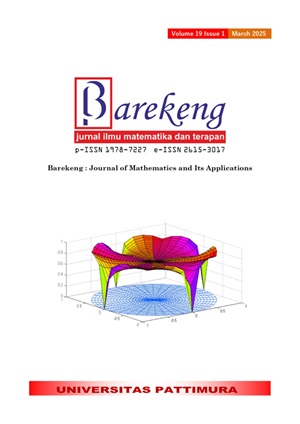CLUSTERING DISTRICTS/CITIES IN EAST JAVA PROVINCE BASED ON HIV CASES USING K-MEANS, AGNES, AND ENSEMBLE
Abstract
Cluster analysis is a method of grouping data into certain groups based on similar characteristics. This research aims to group districts/cities in East Java Province in 2021 based on HIV cases using hierarchical cluster analysis (AGNES), non-hierarchical cluster analysis (K-means), and ensemble clustering. The study found that the ensemble clustering solution forms four clusters, consistent with the results of AGNES clustering. This suggests that ensemble clustering improves the quality of cluster solutions by leveraging both hierarchical and non-hierarchical methods. The grouping of districts/cities based on HIV cases provides a clear distribution pattern for more targeted interventions. The study is limited to HIV cases in East Java Province and may not be generalizable to other regions with different epidemic characteristics. Additionally, the study focuses on clustering methods without investigating temporal changes in HIV case distribution. This research is one of the few studies that applies ensemble clustering to HIV cases in East Java Province. It combines hierarchical and non-hierarchical methods to improve the clustering process and provides a practical approach for regional HIV control planning.
Downloads
References
M. R. Ridlo, S. Defiyanti, dan A. Primajaya, “Implementasi Algoritme K-means Untuk Pemetaan Produktivitas Panen Padi Di Kabupaten Karawang,” dipresentasikan pada Conference on Information Technology and Electrical Engineering (CITEE), Yogyakarta, Jul 2017. [Online]. Tersedia pada: https://docplayer.info/53002307-Implementasi-algoritme-K-means-untuk-pemetaan-produktivitas-panen-padi-di-kabupaten-karawang.html [Diakses: 14 Oktober 2023].
M. W. Talakua, Z. A. Leleury, dan A. W. Taluta, “Analisis Cluster dengan Menggunakan Metode K-means untuk Pengelompokkan Kabupaten/Kota di Provinsi Maluku Berdasarkan Indikator Indeks Pembangunan Manusia Tahun 2014,” BAREKENG: Jurnal Ilmu Matematika dan Terapan, vol. 11, no. 2, Art. no. 2, Des 2017.
S. Nuraidah, “Cluster Ensemble Dalam Penggerombolan Kabupaten/Kota Provinsi Jawa Barat Berdasarkan Indikator Penddikan SMA/SMK/MA.,” Skripsi, Institut Pertanian Bogor, Bogor, 2014.
C. Suhaeni, A. Kurnia, dan R. Ristiyanti, “Perbandingan Hasil Pengelompokan menggunakan Analisis Cluster Berhirarki, K-means Cluster, dan Cluster Ensemble (Studi Kasus Data Indikator Pelayanan Kesehatan Ibu Hamil),” JURNAL MEDIA INFOTAMA, vol. 14, no. 1, hlm. 31–38, Feb 2018.
A. A. Yusfar, M. A. Tiro, dan S. Sudarmin, “Analisis Cluster Ensemble dalam Pengelompokan Kabupaten/Kota di Provinsi Sulawesi Selatan Berdasarkan Indikator Kinerja Pembangunan Ekonomi Daerah,” VARIANSI: Journal of Statistics and Its application on Teaching and Research, vol. 3, no. 1, Art. no. 1, Sep 2020.
D. Y. Nugroho dan A. Wibowo, “Analisis Cluster K-means Kabupaten/Kota di Jawa Timur Berdasarkan Level Epidemik HIV,” Jurnal Biometrika dan Kependudukan (Journal of Biometrics and Population), vol. 8, no. 2, Art. no. 2, Des 2019.
Dinkes Jatim, “Program P2 HIV/AIDS.” 2012. [Daring]. Tersedia pada: https://dinkes.jatimprov.go.id/ userimage/Data%20P2%20sd%20September%20WEB.pdf [Diakses: 14 Oktober 2023].
S. Qian dkk., “Diversity of HIV/AIDS epidemic in China: a result from hierarchical clustering analysis and spatial autocorrelation analysis,” AIDS, vol. 28, no. 12, hlm. 1805, Jul 2014.
X. Yang, J. Zhang, S. Chen, S. Weissman, B. Olatosi, dan X. Li, “Comorbidity patterns among people living with HIV: a hierarchical clustering approach through integrated electronic health records data in South Carolina,” AIDS Care, vol. 33, no. 5, hlm. 594–606, Mei 2021.
K. Moens dkk., “Symptom Clusters in People Living with HIV Attending Five Palliative Care Facilities in Two Sub-Saharan African Countries: A Hierarchical Cluster Analysis,” PLOS ONE, vol. 10, no. 5, hlm. 1–12, Mei 2015.
D. P. S. Dewi dan A. Voutama, “Penerapan Algoritma K-means Pada Kasus HIV Di Jawa Barat Untuk Pengelompokan Berdasarkan Tingkat Penyebaran Di Setiap Kabupaten/Kota Menggunakan Rapidminer,” Jurnal Teknologi Sistem Informasi, vol. 4, no. 2, Art. no. 2, Sep 2023.
W. Rosida dan Y. A. Wijaya, “Klasterisasi Penyakit HIV/AIDS di Jawa Barat Menggunakan Algoritma K-means Clustering,” Blend Sains Jurnal Teknik, vol. 1, no. 4, Art. no. 4, Mar 2023.
K. K. Munawar dan A. I. Purnamasari, “IMPLEMENTASI ALGORITMA K-MEANS CLUSTERING PADA KLASTERISASI KASUS HIV DI JAWA BARAT,” JATI (Jurnal Mahasiswa Teknik Informatika), vol. 7, no. 2, Art. no. 2, Agu 2023.
M. L. Lynch dan V. DeGruttola, “Ensemble clustering of longitudinal bivariate HIV biomarker profiles to group patients by patterns of disease progression,” Int J Data Sci Anal, vol. 14, no. 3, hlm. 305–318, Sep 2022.
N. Wakhidah, “CLUSTERING MENGGUNAKAN K-MEANS ALGORITHM,” Jurnal Transformatika, vol. 8, no. 1, Art. no. 1, Jul 2010.
R. Silvi, “Analisis Cluster dengan Data Outlier Menggunakan Centroid Linkage dan K-means Clustering untuk Pengelompokkan Indikator HIV/AIDS di Indonesia,” JMM, vol. 4, no. 1, hlm. 22–31, Mei 2018.
D. A. Saidah, R. Santoso, dan T. Widiharih, “PENGELOMPOKAN PROVINSI DI INDONESIA BERDASARKAN INDIKATOR KESEHATAN LINGKUNGAN MENGGUNAKAN METODE PARTITIONING AROUND MEDOIDS DENGAN VALIDASI INDEKS INTERNAL,” Jurnal Gaussian, vol. 11, no. 2, Art. no. 2, Agu 2022.
E. Akbari, H. Mohamed Dahlan, R. Ibrahim, dan H. Alizadeh, “Hierarchical cluster ensemble selection,” Engineering Applications of Artificial Intelligence, vol. 39, hlm. 146–156, Mar 2015.
Copyright (c) 2025 Dwi Ayu Lusia, Imelda Salsabila, Heni Kusdarwati, Suci Astutik

This work is licensed under a Creative Commons Attribution-ShareAlike 4.0 International License.
Authors who publish with this Journal agree to the following terms:
- Author retain copyright and grant the journal right of first publication with the work simultaneously licensed under a creative commons attribution license that allow others to share the work within an acknowledgement of the work’s authorship and initial publication of this journal.
- Authors are able to enter into separate, additional contractual arrangement for the non-exclusive distribution of the journal’s published version of the work (e.g. acknowledgement of its initial publication in this journal).
- Authors are permitted and encouraged to post their work online (e.g. in institutional repositories or on their websites) prior to and during the submission process, as it can lead to productive exchanges, as well as earlier and greater citation of published works.






1.gif)



